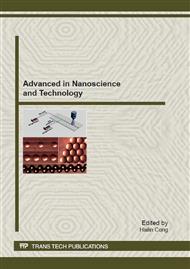[1]
X. G. Zheng, C. N. Xu, Y. Tomokiyo, et al., Evidence of charge stripes, charge-spin-orbital coupling and phase transition in a simple copper oxide CuO, Phys. Re . Lett. 85 (2000) 5170-5179.
DOI: 10.1143/jpsj.70.1054
Google Scholar
[2]
P. Poizot, S. Laruelle, S. Grugeon, et al., Nano-sized transition-metal oxides as negative-electrode materials for lithium-ion batteries, Nature 407 (2000) 496-499.
DOI: 10.1038/35035045
Google Scholar
[3]
J. T. Zhang, J. F. Liu, Q. Peng, et al., Nearly Monodisperse Cu2O and CuO Nanospheres: Preparation and Applications for Sensitive Gas Sensors, Chem. Mater. 18 (2006) 867-871.
DOI: 10.1021/cm052256f
Google Scholar
[4]
J. B. Reitz and E. I. Solomon, Propylene Oxidation on Copper Oxide Surfaces: Electronic and Geometric Contributions to Reactivity and Selectivity, J. Am. Chem. Soc. 120 (1998) 11467-11478.
DOI: 10.1021/ja981579s
Google Scholar
[5]
R. V. Kumar, Y. Diamant, A. Gedanken. Sonochemical synthesis and characterization of nanometer-size transition metal oxides from metal acetates, Chem. Mater. 12 (2000) 2301-2305.
DOI: 10.1021/cm000166z
Google Scholar
[6]
Y. Konishi, T. Nomura, D. Satoh. Solvothermal Preparation of Cuprous Oxide Fine Particles by Hydrolysis of Copper(II) Carboxylate in Two-Phase Liquid−Liquid System, Ind. Eng. Chem. Res. 43 (2004) 2088-(2092).
DOI: 10.1021/ie0305115
Google Scholar
[7]
M. Yin, C. K. Wu, Y. Lou, et al., Copper Oxide Nanocrystals, J. Am. Chem. Soc. 127 (2005) 9506-9511.
Google Scholar
[8]
H. Hou, Y. Xie, Q Li. Large-Scale Synthesis of Single-Crystalline Quasi-Aligned Submicrometer CuO Ribbons, Crystal Growth & Design, Cryst. Growth Des. 5 (2005) 201-205.
DOI: 10.1021/cg049972z
Google Scholar
[9]
Y. Chang and H. C. Zeng. Controlled Synthesis and Self-Assembly of Single-Crystalline CuO Nanorods and Nanoribbons, Cryst. Growth Des. 4 (2004) 397-402.
DOI: 10.1021/cg034127m
Google Scholar
[10]
W. T. Yao, S. H. Yu, Y. Zhou, et al., Formation of Uniform CuO Nanorods by Spontaneous Aggregation: Selective Synthesis of CuO, Cu2O, and Cu Nanoparticles by a Solid−Liquid Phase Arc Discharge Process, J. Phys. Chem. B 109 (2005) 14011-14016.
DOI: 10.1021/jp0517605
Google Scholar
[11]
X. Wen, W. Zhang, S. Yang. Synthesis of Cu(OH)2 and CuO Nanoribbon Arrays on a Copper Surface, Langmuir 19 (2003) 5898-5903.
DOI: 10.1021/la0342870
Google Scholar
[12]
Y. Liu, Y. Chu, Y. Zhuo, et al., Anion-Controlled Construction of CuO Honeycombs and Flowerlike Assemblies on Copper Foils, Cryst. Growth Des. 7 (2007) 467-470.
DOI: 10.1021/cg060480r
Google Scholar
[13]
P. S. Dinesh, K. O. Animesh, N. S. Onkar. Synthesis of Different Cu(OH)2 and CuO (Nanowires, Rectangles, Seed-, Belt-, and Sheetlike) Nanostructures by Simple Wet Chemical Route, J. Phys. Chem. C 113 (2009) 3409-3418.
DOI: 10.1021/jp804832g
Google Scholar


